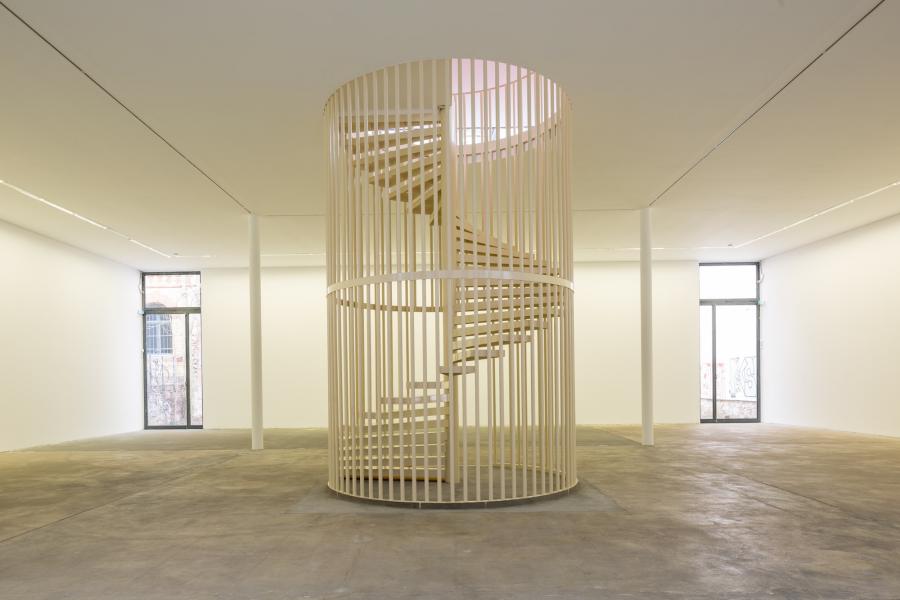Hanne Lippard at KW Institute for Contemporary Art
Hanne Lippard at KW Institute for Contemporary Art

Hanne Lippard's new installation in the recently reopened exhibition hall of KW Institute for Contemporary Art.
The sparseness of KW’s vast ground floor exhibition space is striking; the only object, a central, cage-like structure coated in creamy beige, extends from floor to ceiling. Its interior comprises a spiral staircase that accesses an opening in the ceiling directly above: a portal to Hanne Lippard’s installation, Flesh.
Overlapping, crisscrossing lines of the staircase structure produce layered patterns that shift as the viewer’s position in relation to the object shifts – an optical device that flattens out the space that it shapes, while materializing an echo of Ian Wilson’s circle, which is traced subtly on the ground of an adjacent space. Ascending unsteadily through the disorienting spiral, the audience is ushered through the circular opening onto a plush fleshy-pink carpet sprawled across an uncanny space – a space designed specifically for the exhibition – accentuated by an uncomfortably low ceiling.

Hanne Lippard, Detail of the installation Flesh, 2016, KW Institute for Contemporary Art, 2017; Courtesy the artist and LambdaLambdaLambda, Prishtina; Photo: Frank Sperling
The odd room hovers above the main exhibition hall, enclosed by a series of narrow windows that wrap around its four sides, offering a panorama of the gallery’s elevated surroundings: closely cropped neighboring buildings whose windows offer more of an inward view than out. Wall-length benches line each side, punctuated by speakers in each corner of the room. As the audience settles in, either seated on the inward facing benches along the room’s periphery, or lying submerged in the fibers of the pinky-beige carpet looking upward, Lippard’s voice ushers in another space – one that is fabricated by the converging textures and forms of her words.

Ian Wilson, Circle on the floor, 1968; Chalk, 183 cm Diameter; Installation view: Ian Wilson, Galerie Mot & Van den Boogaard, Brussel; Courtesy the artist and Jan Mot, Brussel.
Speakers placed in the four corners of the room direct the sound and trace the periphery of the space – enclosing it more palpably than the transparent walls. Through persistent and direct address, Lippard’s measured tone and rhythmic recitations emerge as both human and mechanical, while associative chains are built up and broken down to switch gears between numbers and words, between different languages, in a seamless stream. Similar sounding words and letters melt into each other to open out and spread their contents. Positive mantras alternately question and command those present, giving way to broken sequential rhythms and repetitions that illuminate vagueness and incongruous meanings.
The architectural quality of Lippard’s disembodied voice is manifested as language is structured, inhabited, and abruptly vacated within this unlikely space. In the temporary, hovering room that exists both within and outside the physical limits of the exhibition hall, the relationship of voice to body is also articulated, as an extension of it: something both internal and external to it. The openness of the space and the caged spiral of the staircase, reminiscent of bones, articulate its temporal nature and porosity, while, through the voice, language's gaps are fleshed out – retraced along the periphery of physical presence.

Hanne Lippard, Life is short und dann, 2016, photo: Daniele Tognozzi
* * * * *
Hanne Lippard, Flesh
January 20 – April 9, 2017
KW Institute for Contemporary Art
more info